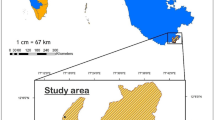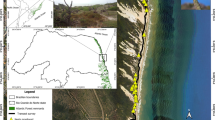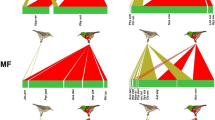Abstract
Rainfall is often indirectly related to the availability of resources, which in turn regulates the abundance of rodents over time. However, the direct influence of rainfall on daily activity is poorly understood, despite the fact that it likely has a great effect on small animals. Furthermore, the influence of the moon on the movement of rodents has been the subject of debate but limited to studies conducted in open areas. Based on a study using pitfall traps in a subtropical region of southern Brazil, this study aimed to investigate the effects of rainfall and the phases of the moon on the daily movements of five species of sigmodontine rodents in a Neotropical forest. Activity patterns were assessed over 130 days, and the daily rainfall and moon phase were verified. Rainfall exhibited a significant positive effect on all studied species. This reflects an increase in the movement of rodents on rainy days, which should be primarily associated with the immediate harmful effects of rain, such as a wet coat and the destruction of shelters. The five species responded differently to moon phase, with a lack of effect for three of them and a positive effect of a full moon on the activity patterns of the other two species. This increase in activity rhythm due to a full moon may indicate a benefit of clear nights for foraging, in contrast to the most common outcome, which associates the brightness of the moon with increased predation risk.



Similar content being viewed by others
References
Bergallo HG (1994) Ecology of a small mammal community in an Atlantic Forest area in southeastern Brazil. Stud Neotropical Fauna Environ 29(4):197–217
Bowers MA, Dooley JL (1993) Predation hazard and seed removal by small mammals: microhabitat versus patch scale effects. Oecologia 94:247–254
Cechin SZ, Martins M (2000) Eficiência de armadilhas de queda (pitfall traps) em amostragens de anfíbios e répteis no Brasil. Revista brasileira de zoologia 17(3):729–740
Clarke JA (1983) Moonlight’s influence on predator/prey interactions between short-eared owls (Asio flammeus) and deermice (Peromyscus maniculatus). Behav Ecol Sociobiol 13:205–209
Emmons LH, Feer F (1997) Neotropical rainforest mammals, a field guide. The University of Chicago Press, Chicago
Feliciano BR, Fernandez FAS, Freitas D, Figueiredo MSL (2002) Population dynamics of small rodents in a grassland between fragments of Atlantic Forest in Southeastern Brazil. Mamm Biol 67:304–314
Fisher DO, Owens IPF (2000) Female home range size and the evolution of social organization in macropod marsupials. J Anim Ecol 69:1083–1098
Galiano D, Kubiak BB, Marinho JR, Freitas TRO (2013) Population dynamics of Akodon montensis and Oligoryzomys nigripes in an Araucaria forest of southern Brazil. Mammalia 77(2):173–179
Graipel ME, Cherem JJ, Monteiro-Filho ELA, Glock L (2006) Dinâmica populacional de marsupiais e roedores no Parque Municipal da Lagoa do Peri, ilha de Santa Catarina, sul do Brasil. Mastozoología Neotropical 13(1): 31-49
Graipel ME, Miller PRM, Glock L (2003) Padrão de atividade de Akodon montensis e Oryzomys russatus na reserva volta velha, Santa Catarina, sul do Brasil. Mastozoología Neotropical 10(2):255–260
Hernández L, Laundré JW, González-Romero A, López-Portillo J, Grajales KM (2011) Tale of two metrics: density and biomass in a desert rodent community. J Mammal 92(4):840–851
IBGE—Instituto Brasileiro de Geografia e Estatística (2011) Mapa de biomas do Brasil. Disponível em: <ftp://ftp.ibge.gov.br/Cartas_e_Mapas/Mapas_Murais/>Access in: 23/04/2012
Jordão JC, Ramos FN, Silva VX (2010) Demographic parameters of Akodon montensis (Mammalia: Rodentia) in an Atlantic Forest remnant of Southeastern Brazil. Mammalia 74:395–400
Kelt DA, Meserve PL, Nabors LK, Forister ML, Gutierrez JR (2004) Foraging ecology of small mammals in semiarid Chile: the interplay of biotic and abiotic effects. Ecology 85:383–397
Lima M, Ernest SKM, Brown JH, Belgrano A, Stenseth NC (2008) Chihuahuan desert kangaroo rats: nonlinear effects of population dynamics, competition, and rainfall. Ecology 89(9):2594–2603
Lockard RB, Owings DH (1974) Seasonal variation in moonlight avoidance by bannertail kangaroo rats. J Mammal 55:189–193
Longland WS, Price MV (1991) Direct observations of owls and heteromyid rodents: can predation risk explain microhabitat use? Ecology 72:2261–2273
Mallmann AS, Finokiet M, Dalmaso AC, Melo GL, Ferreira VL, Cáceres NC (2011) Dinâmica populacional e reprodução de pequenos mamíferos de uma floresta estacional do Maciço do Urucum, oeste do Pantanal, Brasil. Neotropical Biol Conserv 6(2):94–102
Mendel SM, Vieira MV (2003) Movement distances and density estimation of small mammals using the spool-and-line technique. Acta Theriol 48(3):289–300
Meserve PL, Kelt DA, Previtali MA, Milstead WB, Gutiérrez JR (2011) Global climate change and small mammal populations in north-central Chile. J Mammal 92(6):1223–1235
Meynard CN, Pillay N, Perrigault M, Caminade P, Ganem G (2012) Evidence of environmental niche differentiation in the striped mouse (Rhabdomys sp.): inference from its current distribution in southern Africa. Ecol Evol 2(5):1008–1023
Mohammadi S (2010) Microhabitat selection by small mammals. Adv Biol Res 4(5):283–287
Naxara L, Pinotti BT, Pardini R (2009) Seasonal microhabitat selection by terrestrial rodents in an old-growth Atlantic forest. J Mammal 90(2):404–415
Netto RS, Salmoria V, Sant’Anna FS. Vegetação (2012) In: Cherem JJ, Samoria V (Eds) Fisiografia, Flora e Fauna do Rio Irani. ETS, Florianópolis, p 28-32
O’Farrell MJ (1974) Seasonal activity patterns of rodents in a sagebrush community. J Mammal 55(4):809–823
Paglia AP, Fonseca GAB, Rylands AB, Herrmann G, Aguiar LMS, Chiarello AG, Leite YLR, Costa LP, Siciliano S, Kierulff MCM, Mendes SL, Tavares VC, Mittermeier RA, Patton JL (2012) Annotated checklist of Brazilian mammals. 2 ed. Occasional Papers in Conservation Biology n.6, Conservation International, Arlington, 76p
Pardini R, Umetsu F (2006) Pequenos mamíferos não-voadores da Reserva Florestal do Morro Grande—distribuição das espécies e da diversidade em uma área de Mata Atlântica. Biota Neotropica 6(2)
Passamani M (2000) Análise da comunidade de marsupiais em Mata Atlântica de Santa Teresa, Espírito Santo. Boletim do Museu de Biologia Mello Leitão 11(12):215–228
Peel MC, Finlayson BL, Mcmahon TA (2007) Updated world map of the Köppen-Geiger climate classification. Hydrol Earth Syst Sci 11:1633–1644
Prevedello JA, Mendonça AF, Vieira MV (2008) Uso do espaço por pequenos mamíferos: uma análise dos estudos realizados no Brasil. Oecologia Brasiliensis 12(4):610–625
Price MV, Kramer KA (1984) On measuring microhabitat affinities with special reference to small mammals. Oikos 42:349–354
Prugh L, Brashares J (2010) Basking in the moonlight? Effect of illumination on capture success of the endangered giant kangaroo rat. J Mammal 91(5):1205–1212
Püttker T, Meyer-Lucht Y, Sommer S (2006) Movement distances of five rodent and two marsupial species in forest fragments of the coastal Atlantic rainforest, Brazil. Ecotropica 12:131–139
R Development Core Team (2013) R: A language and environment for statistical computing. R Foundation for Statistical Computing, Vienna, Austria. ISBN 3-900051-07-0, URL http://www.R-project.org/
Reis NR, Peracchi AL, Fregonezi MN, Rossaneis BK (2009) Mamíferos do Paraná. Pelotas, Ed. USEB, 220p
Santos-Filho M, da Silva DJ, Sanaiotti TM (2008) Variação sazonal na riqueza e na abundância de pequenos mamíferos, na estrutura da floresta e na disponibilidade de artrópodes em fragmentos florestais no Mato Grosso, Brasil. Biota Neotropica 8(1):115–121
Silva-Filho FA, Pugues S. Vegetação (2008) In: Cherem JJ, Kammers M (Org) A fauna das áreas de influência da Usina Hidrelétrica Quebra-Queixo. Habilis Editora Erechim, Brasil, p 44-56
Stokes MK, Slade NA, Blair SM (2001) Influences of weather and moonlight on activity patterns of small mammals: a biogeographical perspective. Can J Zool 79:966–972
Umetsu F, Naxara L, Pardini R (2006) Evaluating the efficiency of pitfall traps for sampling small mammals in the neotropics. J Mammal 87(4):757–765
Umetsu F, Metzger JP, Pardini R (2008) Importance of estimating matrix quality for modeling species distribution in complex tropical landscapes: a test with Atlantic forest small mammals. Ecography 31:359–370
Upham NS, Hafner JC (2013) Do nocturnal rodents in the Great Basin Desert avoid moonlight? J Mammal 94(1):59–72
Vieira EM, Paise G, Machado PHD (2006) Feeding of small rodents on seeds and fruits: a comparative analysis of three species of rodents of the Araucaria forest, southern Brazil. Acta Theriol 51:311–318
Acknowledgments
We thank Martin Maurer, Joana Boschetti, and Elaine M. L. Gonsales for their help in the field and the AURORA industry for authorization and support for our fieldwork. We thank Rodrigo Fornel, Thales R. O. de Freitas, and Carlos Benhur Kasper for reading an early version of the manuscript and for their valuable suggestions about it, and Rodrigo Fornel, who prepared the map. We thank CAPES for granting a scholarship to the first author.
Author information
Authors and Affiliations
Corresponding author
Additional information
Communicated by: Matthew E. Gompper
Electronic supplementary material
Below is the link to the electronic supplementary material.
ESM 1
(PDF 203 kb)
Rights and permissions
About this article
Cite this article
Maestri, R., Marinho, J.R. Singing in the rain. Rainfall and moonlight affect daily activity patterns of rodents in a Neotropical forest. Acta Theriol 59, 427–433 (2014). https://doi.org/10.1007/s13364-014-0177-x
Received:
Accepted:
Published:
Issue Date:
DOI: https://doi.org/10.1007/s13364-014-0177-x




